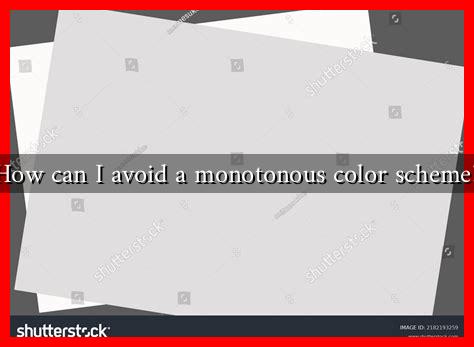-
Table of Contents
How Can I Avoid a Monotonous Color Scheme?
Color plays a crucial role in design, influencing emotions, perceptions, and even behaviors. A well-thought-out color scheme can elevate a project, while a monotonous one can lead to disengagement. Whether you are designing a website, creating a marketing campaign, or redecorating your home, avoiding a dull color palette is essential. This article explores effective strategies to keep your color schemes vibrant and engaging.
Understanding Color Theory
Before diving into practical tips, it’s important to grasp the basics of color theory. Color theory encompasses the principles of how colors interact, their emotional impacts, and how they can be combined effectively. Here are some key concepts:
- Color Wheel: The color wheel is a visual representation of colors arranged according to their chromatic relationship. Primary colors (red, blue, yellow) can be mixed to create secondary colors (green, orange, purple).
- Complementary Colors: These are colors located opposite each other on the color wheel. For example, blue and orange create a striking contrast that can energize a design.
- Analogous Colors: These colors are next to each other on the color wheel, such as blue, blue-green, and green. They create a harmonious look but can risk monotony if not balanced with contrasting elements.
Strategies to Avoid Monotony
Now that you understand the basics of color theory, let’s explore practical strategies to avoid a monotonous color scheme:
1. Use a Color Palette Generator
Color palette generators can help you discover new combinations that you might not have considered. Tools like Coolors and Adobe Color allow you to create and explore various palettes based on your preferences. These tools often provide options for complementary, analogous, and triadic color schemes.
2. Incorporate Neutrals
While vibrant colors are essential, incorporating neutral tones can provide balance and prevent overwhelming the viewer. Neutrals like white, gray, and beige can serve as a backdrop, allowing brighter colors to stand out. For example, a bright yellow accent wall can pop against a soft gray sofa.
3. Experiment with Textures and Patterns
Adding textures and patterns can break the monotony of a color scheme. Consider the following:
- Textured Materials: Use materials like wood, metal, or fabric to add depth to your design.
- Patterns: Incorporate patterned textiles, wallpapers, or artwork to introduce visual interest without relying solely on color.
4. Limit Your Color Palette
Sometimes, less is more. Limiting your color palette to three to five colors can create a cohesive look while still allowing for variety. This approach encourages thoughtful selection and can lead to a more sophisticated design. For instance, a minimalist website might use a primary color, a secondary color, and a neutral to create a clean aesthetic.
5. Use Accent Colors Wisely
Accent colors can add vibrancy to your design without overwhelming it. Choose one or two accent colors that complement your primary palette. For example, if your primary colors are blue and gray, a bright orange can serve as an effective accent, drawing attention to key elements.
Case Studies and Examples
Many successful brands have mastered the art of color schemes. For instance, Spotify uses a bold green against a dark background, creating a striking contrast that is both modern and engaging. Similarly, Airbnb employs a soft pink and white palette that feels inviting and warm, avoiding monotony through the use of varying shades and textures.
Conclusion
Avoiding a monotonous color scheme is essential for creating engaging and effective designs. By understanding color theory, utilizing tools, incorporating neutrals, experimenting with textures, limiting your palette, and using accent colors wisely, you can create vibrant and dynamic color schemes. Remember, the goal is to evoke emotions and create a memorable experience for your audience. With these strategies in mind, you can confidently approach your next design project without falling into the trap of monotony.

